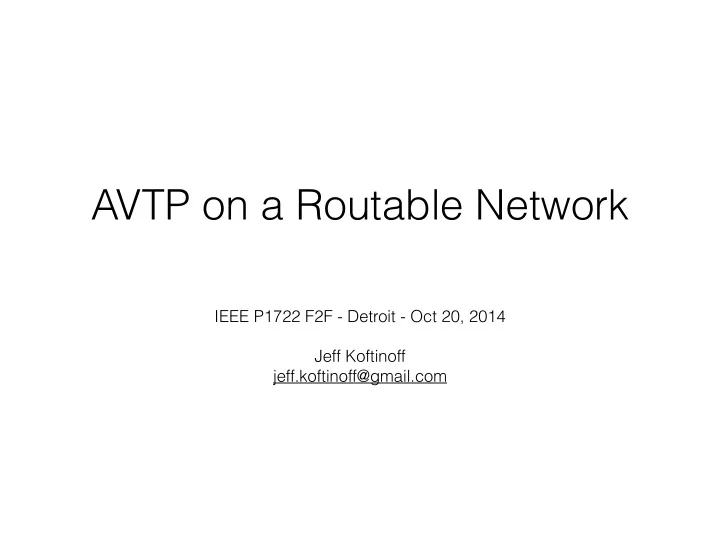

AVTP on a Routable Network IEEE P1722 F2F - Detroit - Oct 20, 2014 Jeff Koftinoff jeff.koftinoff@gmail.com
IEEE P1722 Draft 10 Annex J • Enables transport of AVTP and AVDECC protocols via UDP on IPv4 and IPv6 networks • Destination UDP port 17220 is used for streams (“Continuous”) • Destination UDP port 17221 is used for control (“Discrete”) • UDP payload for both contains a 32 bit extended sequence number followed by the AVTPDU payload starting with the “subtype” field 2
AVTP Stream Transport Options • Stream “Flows” are always defined by the unique “StreamID” field which always contains a MAC address • Transport options for AVTP Streams include: • Ethernet via EtherType 0x22F0 • IPv4/IPv6 via UDP (Default Port 17220) • Multi-Protocol Label Switching (MPLS) via managed path 3
AVTP streams on Ethernet review • EtherType 0x22F0 • Requires a VLAN tag with priority value which is typically assigned via SRP Domain vector but may be administratively assigned via IEEE 1722.1-2013 SET_STREAM_INFO command • Destination Address is typically a multicast MAC address negotiated via IEEE 1722-2011 MAAP or assigned via the IEEE 1722.1-2013 SET_STREAM_INFO command. 4
IP streaming multicast across a single subnet using SRP • Standard destination UDP port is 17220, ephemeral ports may be used • SRP is used to manage bandwidth and traffic shaping • SRP requires the stream’s UDP messages to be tagged with an appropriate VLAN and Priority • SRP requires the stream’s UDP messages to be sent to a unique multicast MAC address which maps to the destination Multicast IP address • See RFC7042 for mapping Multicast IP addresses to MAC Addresses • As the destination multicast IP addresses used for each stream are required to map to unique MAC addresses, every stream’s destination address needs to be either administratively managed by a central controller or dispensed by a MADCAP server (See RFC2730) or other 5
IP streaming multicast across local subnets using SRP • Same base requirements as the single subnet case adding SRP Talker Pruning (IEEE Std 802.1Q-2011 Clause 35.2.1.4b) and MMRP (See IEEE Std 802.1Q-2011 Clause 5.16.1) • A Router can then declare SRP attributes between IP subnets on an “As needed” basis • All subnets are required to be in an “equivalent” IEEE 802.1AS gPTP clock domain; i.e. the same GMID via PTP Boundary Clock, or GPS synchronized GM 6
IP streaming unicast without SRP • Destination IP Addresses are unicast • Standard destination UDP port is 17220, ephemeral ports may be used to allow for multiple streams to the same destination IP address • Bandwidth and worst case latency are not guaranteed • Stream UDP messages do not need to be VLAN tagged • Useful for point to point streams on managed networks or tunnels • Stream UDP messages may take advantage of Differentiated Services as defined in RFC2474 using DiffServ class AF41 (DSCP decimal value 34) to help with traffic shaping and prioritization (See RFC2597 Section 6) 7
Wide Area Network streaming using MPLS • RFC4901 specifies how to transport UDP efficiently through an MPLS “PseudoWire.” • COMPRESSED_UDP_16 mode allowing for 65536 unique streams between two networks connected via MPLS routers over the Internet. • The data payload is the UDP payload as defined by IEEE P1722A D10 Annex J with the UDP header replaced by the MPLS label stack and 16 bit flow identifier • Bandwidth and worst case latency are only guaranteed by the administration of the MPLS label stack for the flow and the SRP parameters at each end • MPLS requires that the path from talker to listener be administratively configured, and in so doing can be configured for traffic shaping, multicast, redundant paths, and bandwidth reservation. 8
Recommend
More recommend